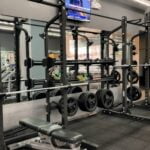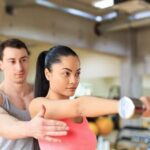Are you wondering what are some fitness exercises to incorporate into your routine? Physical activity is essential for overall health and wellness, and there are numerous types of exercises to choose from. In this article, we will explore the benefits of regular exercise and discuss various types of fitness routines to help you achieve your health and fitness goals.
Regular physical activity offers a multitude of benefits for both the body and mind. From improving cardiovascular health and building muscle to enhancing flexibility and reducing stress, exercise plays a crucial role in maintaining a healthy lifestyle. Whether you are new to fitness or a seasoned athlete, there is an exercise routine that can be tailored to suit your needs and preferences.
In the following sections, we will delve into different categories of fitness exercises including cardiovascular workouts, strength training, flexibility exercises, high-intensity interval training (HIIT), low-impact exercises, bodyweight workouts, and tips for incorporating exercise into your daily routine. By the end of this article, you will have a better understanding of the various options available for achieving your fitness goals. So let’s dive in and explore the world of fitness exercises.
Benefits of Regular Exercise
Regular exercise offers a wide range of benefits for both physical and mental well-being. Incorporating fitness exercises into your routine can lead to improved overall health, increased energy levels, and a reduced risk of chronic diseases. Additionally, regular physical activity can have a positive impact on mental health, reducing symptoms of stress, anxiety, and depression.
Physical Benefits
Engaging in fitness exercises on a regular basis can lead to numerous physical benefits. These include weight management, improved cardiovascular health, and a reduced risk of conditions such as heart disease, high blood pressure, and type 2 diabetes. Regular exercise also helps to strengthen the muscles and bones, enhancing overall physical strength and endurance.
Mental Health Benefits
In addition to the physical benefits, regular exercise is also associated with numerous mental health benefits. Physical activity has been shown to reduce symptoms of stress and anxiety while improving mood and overall mental well-being. Exercise stimulates the release of endorphins in the brain, which are known as “feel-good” hormones that can contribute to an overall sense of happiness and relaxation.
Long-Term Health Benefits
Engaging in regular fitness exercises can have long-term health benefits as well. Research has shown that individuals who maintain an active lifestyle are at a lower risk for developing chronic conditions such as osteoporosis and certain types of cancer. Furthermore, regular exercise is associated with increased longevity and improved quality of life in later years. By prioritizing regular physical activity, individuals can significantly improve their overall health and well-being over time.
Types of Cardiovascular Exercises
Cardiovascular exercises, also known as aerobic exercises, are crucial for improving the health of your heart and lungs. These types of exercises increase your heart rate and breathing for an extended period of time, which helps to strengthen your cardiovascular system. There are many different types of cardiovascular exercises that you can incorporate into your fitness routine to keep it fun and effective.
Running and Jogging
Running and jogging are popular cardiovascular exercises that can be done outdoors or on a treadmill. They help to improve stamina, endurance, and overall cardiovascular health. Whether you prefer a leisurely jog or a high-intensity sprint, running is a great way to get your heart pumping.
Swimming
Swimming is an excellent low-impact exercise that provides a full-body workout while being gentle on the joints. This makes it particularly beneficial for individuals with joint pain or arthritis. Swimming laps or participating in water aerobics classes are both effective ways to improve cardiovascular fitness.
Cycling
Cycling is not only a great mode of transportation, but it also serves as an effective cardiovascular exercise. Whether you’re cycling outdoors or taking a spin class indoors, this low-impact exercise helps to strengthen leg muscles while providing an intense cardio workout.
Cardiovascular exercises should be performed for at least 150 minutes per week, according to the American Heart Association. However, you can break this down into smaller sessions throughout the week if needed. Incorporating a variety of cardiovascular exercises into your routine will help keep things interesting while providing numerous health benefits.
Strength Training Exercises for Building Muscle
When it comes to building muscle, strength training exercises are essential. These types of exercises not only help in increasing muscle mass, but also aid in improving overall strength and endurance. Here are some examples of strength training exercises that are commonly used for building muscle:
- Squats: This exercise targets the lower body muscles including the quadriceps, hamstrings, and glutes.
- Deadlifts: Deadlifts work multiple muscle groups including the back, glutes, hamstrings, and core.
- Bench Press: This exercise is great for targeting the chest, shoulders, and triceps.
- Pull-ups/Chin-ups: These exercises target the upper body muscles including the back, biceps, and shoulders.
It’s important to remember that proper form is crucial when performing strength training exercises to prevent injury and get the most out of each movement. Additionally, adjusting weight and repetitions can impact muscle growth and overall strength gains.
Incorporating a variety of these strength training exercises into your workout routine can lead to balanced muscle development throughout the entire body. Remember to start with lighter weights if you’re a beginner and gradually increase as your strength improves.
Flexibility and Stretching Exercises
Flexibility and stretching exercises are an essential component of any fitness routine. They help to improve range of motion, prevent injury, and reduce muscle tension. Flexibility exercises work by lengthening the muscles and can include activities such as yoga, Pilates, or simple stretching exercises. These types of exercises can be done at any time of day and are especially beneficial after a workout when the muscles are warm.
One popular form of flexibility exercise is yoga, which incorporates poses that target specific muscle groups while also focusing on breathing and relaxation. Many people find that practicing yoga not only improves their flexibility but also helps to reduce stress and promote overall well-being. Another effective form of flexibility exercise is Pilates, which focuses on core strength and stability through precise movements that require control and concentration.
It’s important to incorporate flexibility exercises into your fitness routine in order to maintain balance within your body’s musculature. By doing so, you can prevent muscle imbalances from occurring, which can lead to pain or injury over time. Additionally, stretching exercises can help to alleviate muscle stiffness and improve posture, making everyday activities easier and more comfortable.
| Flexibility Exercise | Benefits |
|---|---|
| Yoga | Improves flexibility, reduces stress, |
| Pilates | Strengthens core muscles, enhances stability |
High Intensity Interval Training (HIIT) Workouts
High Intensity Interval Training (HIIT) is a form of cardiovascular exercise that alternates between intense bursts of activity and periods of rest or low-intensity exercise. This type of workout has gained popularity in recent years due to its efficiency in burning calories and improving cardiovascular health. HIIT workouts can be done with various types of exercises such as sprinting, cycling, or bodyweight movements like burpees or jumping jacks.
One of the main benefits of HIIT workouts is that they can be completed in a shorter amount of time compared to steady-state cardio exercises, making them ideal for individuals with busy schedules. Research has shown that HIIT can help increase metabolism, improve insulin sensitivity, and reduce abdominal fat. Additionally, the intensity of HIIT workouts can also lead to improved oxygen consumption and overall endurance.
When performing a HIIT workout, it’s important to warm up properly to prevent injury and prepare the body for the high-intensity intervals. It’s recommended to start with a 5-10 minute dynamic warm-up that includes movements like leg swings, arm circles, and light jogging.
During the high-intensity intervals, individuals should aim to work at 90-100% of their maximum heart rate for 20-60 seconds followed by a period of active recovery or complete rest. Beginners may start with shorter intervals and gradually increase the duration as they build endurance.
| Benefits | Tips |
|---|---|
| Increases metabolism | Start with a proper warm-up |
| Improves insulin sensitivity | Gradually increase interval duration |
| Reduces abdominal fat | Aim for 90-100% maximum heart rate during intervals |
Low Impact Exercises for Joint Health
When it comes to fitness exercises, low impact exercises are a great option for those looking to maintain joint health while still getting a good workout. These exercises are easy on the joints and can help reduce the risk of injury, making them especially beneficial for individuals with arthritis, joint pain, or those who are recovering from an injury. Here are some examples of low impact exercises that you can incorporate into your fitness routine:
- Walking: Walking is a simple yet effective form of low impact exercise that can be done anywhere. It helps improve cardiovascular health and strengthen the muscles in the lower body without putting excessive strain on the joints.
- Swimming: Swimming is another excellent low impact exercise that provides a full-body workout. The buoyancy of water reduces the impact on the joints, making it an ideal option for individuals with joint pain or mobility issues.
- Cycling: Whether it’s outdoor cycling or using a stationary bike, cycling is a low impact exercise that helps improve leg strength and cardiovascular endurance without placing stress on the joints.
By incorporating these low impact exercises into your fitness routine, you can reap the benefits of regular exercise without putting unnecessary strain on your joints. Remember to start slowly and gradually increase the intensity and duration of your workouts as your fitness level improves. It’s also important to listen to your body and stop any exercise that causes pain or discomfort in your joints.
Bodyweight Exercises for at-Home Workouts
Bodyweight exercises are a great option for individuals who prefer to work out at home, as they require minimal equipment and can be done virtually anywhere. These exercises utilize the body’s own weight to create resistance, making them an effective way to build strength and muscle. Some popular bodyweight exercises include push-ups, squats, lunges, and planks.
One of the main advantages of bodyweight exercises is that they are suitable for individuals of all fitness levels. Beginners can modify the exercises to make them less challenging, while more advanced individuals can add variations or increase the intensity to continue seeing results. Additionally, bodyweight exercises are versatile and can be easily customized to target different muscle groups or specific areas of the body.
When performing bodyweight exercises, it’s important to focus on proper form and technique to avoid injury and maximize the effectiveness of the workout. It’s also helpful to incorporate a variety of different bodyweight exercises into your routine to ensure that you are targeting all major muscle groups.
Finally, consider adding in some cardio intervals between sets or incorporating high-intensity intervals for a more challenging workout. Overall, bodyweight exercises offer a convenient and efficient way to stay in shape without needing access to a gym or specialized equipment.
Incorporating Fitness Exercises Into Your Daily Routine
One of the key benefits of incorporating fitness exercises into your daily routine is the improvement in cardiovascular health. Activities such as walking, running, swimming, or cycling can help strengthen the heart and lungs while also reducing the risk of heart disease. Additionally, engaging in strength training exercises like weightlifting or bodyweight workouts can help build muscle mass and boost metabolism, leading to better weight management and increased energy levels.
To successfully incorporate fitness exercises into your daily routine, it’s important to find activities that you enjoy and that fit seamlessly into your schedule. This could mean going for a walk during lunch breaks, doing a quick HIIT workout before breakfast, or participating in a yoga class after work.
By making physical activity a priority in your day-to-day life, you’ll be more likely to stick with it and reap the long-term benefits of regular exercise. Remember, even small amounts of activity throughout the day can add up and make a significant impact on your overall health.
Frequently Asked Questions
What Are 10 Common Exercises?
10 common exercises include squats, lunges, push-ups, planks, deadlifts, burpees, jumping jacks, running or jogging, cycling, and yoga. These exercises target different muscle groups and promote overall strength and flexibility.
What Are the 10 Types of Fitness?
The 10 types of fitness are cardiovascular endurance, muscular strength, muscular endurance, flexibility, balance, agility, speed, power, coordination, and reaction time. These different types of fitness contribute to an individual’s overall physical well-being and performance in various activities.
What Are the Big 5 Exercise?
The Big 5 exercises refer to the five fundamental compound movements: squatting, deadlifting or hip hinge movements, pushing (such as a bench press), pulling (like a row or pull-up), and carrying or loaded carries. These exercises are considered essential for building functional strength and athleticism due to their ability to target multiple muscle groups simultaneously.

Passionate about providing useful information to anyone with an interest in the field of Personal Training, I strive to pass on to our readers quality information and to answer any questions about Personal Trainers, the work they do and how to become one.





